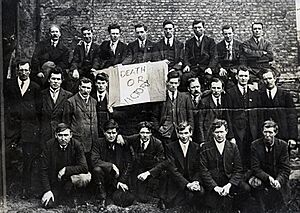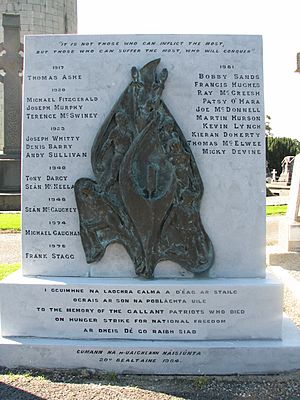1923 Irish hunger strikes facts for kids
In October 1923, many Irish republican prisoners started a mass hunger strike. They were protesting because they were being held in prison without a court hearing or being charged with a crime, a practice called internment. The Irish Civil War had ended six months earlier, but the new government of the Irish Free State was slow to let go of the thousands of Irish republican prisoners. These prisoners had been against the Anglo-Irish Treaty, which was a peace agreement that ended the fight for Irish independence but also split Ireland.
Contents
Why Hunger Strikes Happened
In the 1900s, 22 Irish republicans died while on hunger strike. These strikes were used as a last resort by Irish republican prisoners to protest. Between 1913 and 1922, there were about a dozen hunger strikes in Ireland. Several people died, and many others had serious health problems later on.
Thomas Ashe died on September 25, 1917, in Mountjoy Prison because of force-feeding. He was arrested for giving a speech that caused trouble. After Ashe's death, the remaining prisoners on strike were given special status as political prisoners, and their hunger strike ended.
Mountjoy Prison Strike of 1920
A very well-known hunger strike began on April 5, 1920. Thirty-six men in Mountjoy Prison started it. They were protesting being held without charges or trials and demanded to be released or treated as political prisoners. Eventually, 101 men joined the strike, which got a lot of attention from newspapers and people. This was the biggest hunger strike in Irish history at that time.
After large protests (with 5,000 to 10,000 people) and a general strike across Dublin, the government released the prisoners on April 14, 1920. Peadar Clancy and Frank Gallagher led the Mountjoy hunger strikers. They refused to give in to the prison authorities. After 14 days, Clancy successfully got all the hunger strikers in Mountjoy released.
Cork Prison Strike of 1920
On August 13, 1920, seventy-eight Irish republican prisoners started a hunger strike in Cork County Gaol. They demanded to be released right away, without any conditions. Important people in this group included Terence MacSwiney, who was the Lord Mayor of Cork, and Liam Lynch, an Irish Republican Army (IRA) leader. After one week, all but 11 of the strikers were released or sent to prisons in England.
During this strike, people in Cork stopped work three times to attend church services for the hunger strikers. On November 12, 1920, after 94 days, Arthur Griffith told the men to end their strike. He said they had "sufficiently proved their devotion and fidelity" and should now "live for Ireland" instead of dying for it.
When the hunger strike ended, the nine remaining strikers needed to go to the hospital. All of them died relatively young. This strike led to three deaths from starvation: MacSwiney died on October 25, 1920, in Brixton Prison in London. Two other men, Michael Fitzgerald and Joe Murphy, died in Cork Gaol on October 17 and October 25, 1920, respectively.
End of the Irish Civil War
By spring 1923, the anti-Anglo-Irish Treaty Irish Republican Army (IRA) knew they could not win the Irish Civil War. On April 20, 1923, Frank Aiken became the leader of the anti-treaty IRA. He ordered them to stop fighting on April 30. His order to "dump arms" (give up weapons) on May 24, 1923, effectively ended the war. Aiken wrote that they had fought to free their country and would keep their weapons until they found an honorable way to reach their goal without fighting.
Since there was no big battle or official surrender, the Irish Free State Army continued to arrest and hold Republicans in prison. The war was over, but the Irish Free State still had about 12,000 anti-treaty men and women in prison. The Free State government did not offer a general pardon to these IRA prisoners until 1924. This meant many prisoners stayed locked up long after the war ended.
1923 Hunger Strikes Begin
In early 1923, hunger strikes were not an official plan of the IRA. Instead, each prisoner decided on their own to strike. Several individual and large hunger strikes happened in 1923.
Women Hunger Strikers
In February 1923, 50 women from Cumann na mBan went on hunger strike for 34 days. Cumann na mBan was an Irish republican women's group formed in 1914. These women were protesting the arrest and imprisonment of Irish republican prisoners without trial. Famous members included Maire Comerford, Mary MacSwiney, Sheila Humphreys, and Lily O'Brennan. That strike led to the release of the women hunger strikers.
In March 1923, 97 women went on hunger strike in Kilmainham Gaol. They did this after all their special rights were taken away without explanation. That hunger strike ended later in the month when their rights were given back. Annie (Nan) Hogan, a Cumann na mBan member, died at age 24 in September 1923. She was released from prison "in a very thin state" because of her hunger strikes in Kilmainham and the North Dublin Union jails. Hogan was arrested for helping Republicans try to escape from Limerick Jail.
Constance Markievicz was a leader of Sinn Fein, a revolutionary, and against the Anglo-Irish Treaty. She was also the first woman elected to the British parliament, though she refused to take her seat. She was arrested many times. In November 1923, she went on hunger strike until all Irish Republican women prisoners were released, which happened just before Christmas. During this time, Cumann na mBan members protested constantly outside Mountjoy Prison.
Mass Hunger Strikes
By October 1923, about 5,000 Irish republicans were on strike. In October 1923, the new Irish Government hinted that all prisoners would be released by Christmas. Many of these prisoners had been held for over a year.
The largest hunger strike in Irish history began at midnight on October 14, 1923, in Mountjoy Prison. Peadar O'Donnell led the Irish Civil War prisoners there. He asked the IRA General Headquarters (GHQ) to send a message to other prisons and camps, telling them about their plan to start a hunger strike. Many hunger strikes began soon after this message was received.
The mass hunger strikes of October and November 1923 saw thousands of Irish republican prisoners on strike. They were in prisons and internment camps across Ireland. They protested being held without charges or trials and demanded immediate release or status as political prisoners. Before this, the Irish Free State government had made a rule against releasing prisoners who were on hunger strike. In Dublin, thousands of protesters stayed outside the prisons, often singing or praying.
Estimates of how many prisoners joined the mass hunger strikes in 1923 range from 2,000 to 8,000. One estimate says that by October 24, 1923, about 7,000 men were on hunger strike. This included 3,900 in the Curragh Camp, 1,700 in Newbridge Prison, 462 in Mountjoy Prison, 70 in Cork City Gaol, 350 in Kilkenny Prison, 200 in Dundalk Gaol, 711 in Gormanstown Internment Camp, and 263 on the Prison Ship Argenta in Belfast Lough.
The protest lasted 41 days and spread to at least ten other prisons and camps. By late October, many strikers had ended their hunger strike after being promised release. On November 12, 1923, the hunger strike in Cork jail was called off. After a sixteen-day hunger strike, all women prisoners held in the North Dublin Union were released on November 17, 1923. At the end of the hunger strike, many men had been fasting for more than 34 days.
1923 Irish Hunger Strike Deaths
On June 10, 1923, Dan Downey died in the Curragh Camp because of an earlier hunger strike. Joseph Whitty, who was 19, went on his own hunger strike and died on August 2, 1923, also in the Curragh Camp. Whitty was the first of three IRA men to die on hunger strike in 1923.
Several deaths happened due to starvation near the end of the 41-day hunger strike:
- Denny Barry from County Cork, died November 20, 1923, in Mountjoy Prison.
- Andy O'Sullivan from County Cavan, died November 23, 1923, also in Mountjoy Prison.
- On December 24, 1923, Joe Lacey died at the Curragh Camp. The hunger strike had ended in November, but Lacey died because he was so weak.
End of Strike and Release of Prisoners
The protest was called off on November 23, 1923, by leaders in the prisons and camps. These leaders included Thomas Derrig in Kilmainham Gaol, Michael Kilroy, Frank Gallagher, and Peadar O'Donnell in Mountjoy. On that day, 176 men were still on hunger strike. Some had been striking for 41 days, others for 34 days. Messages were sent from Kilmainham Gaol to each prison, saying that all prisoners would end the strike together. The day after the strike ended, on November 24, 1923, more than 500 prisoners were released from prisons across Ireland.
With the end of the mass hunger strikes, many men were released within a month. They had to sign an oath of loyalty to the new Irish Free State. Prisoner leader Peadar O’Donnell said about this required signature: "...they demanded that each one sign a form that he would accept the rule of the new garrison in Ireland."
Even though many prisoners were released in November 1923, five or six hundred remained in prison until late December. In June 1924, 120 prisoners were released from different prisons, leaving 300 still locked up. Ernie O'Malley, who was a high-ranking officer in the Anti-Treaty IRA during the Civil War, was released from the Curragh along with Seán Russell on July 17, 1924. This was more than a year after the fighting ended. It wasn't until January 1926 that the last republican prisoners were released from Derry Gaol in Northern Ireland.
What Happened After the 1923 Hunger Strikes
Even though the fighting was mostly over, the bad feelings from the Irish Civil War continued. As late as 1924, there were "constant raids on victims homes in an effort to eradicate the last vestige of resistance." Many men and women who had been on long hunger strikes never fully recovered and died young. Because the Free State government preferred to hire people who supported them, many Anti-Treaty Irish republicans left Ireland.
Later in the 1900s, Irish republicans continued to use hunger strikes as a last resort protest:
- Tony D'Arcy died on April 16, 1940, after a 52-day hunger strike.
- Jack McNeela died on April 19, 1940, after 55 days on hunger strike.
- Seán McCaughey died on May 11, 1946, after 23 days on hunger strike.
- Michael Gaughan died on June 3, 1974, after 55 days on hunger strike and forced feedings.
- Frank Stagg died on February 12, 1976, after 62 days on hunger strike in Wakefield Prison, England.
In October and November 1980, seven Irish republican prisoners went on hunger strike in HM Prison Maze in Northern Ireland. That strike ended after 53 days. Ten Irish republicans died during the 1981 Irish hunger strike between March and October 1981.



